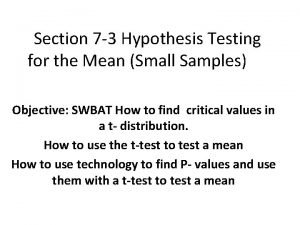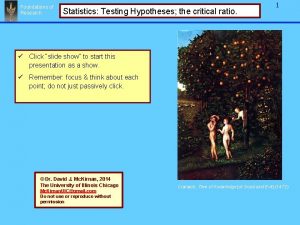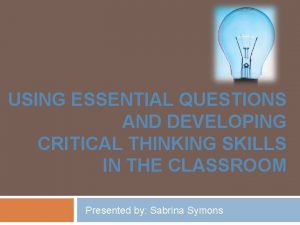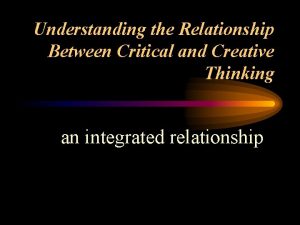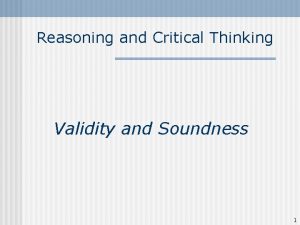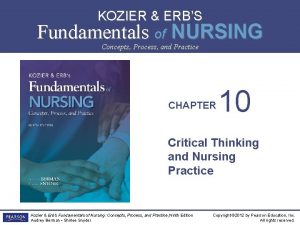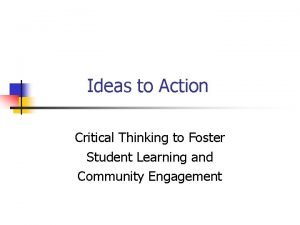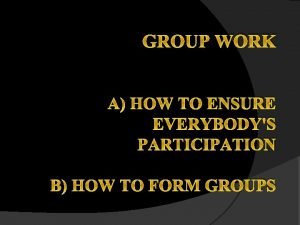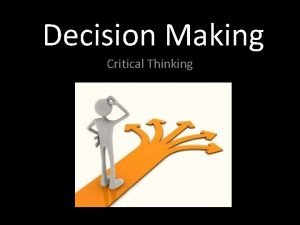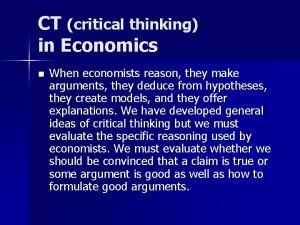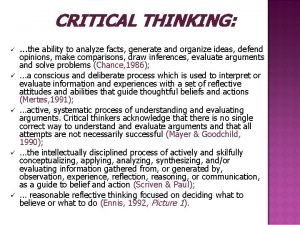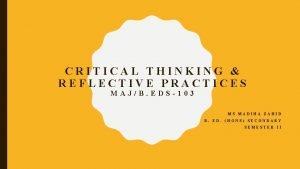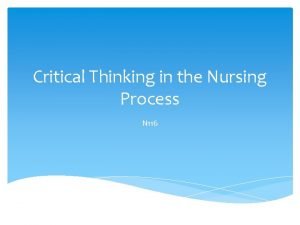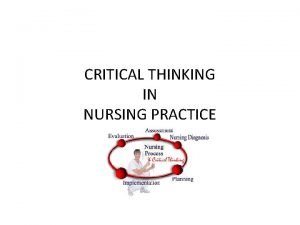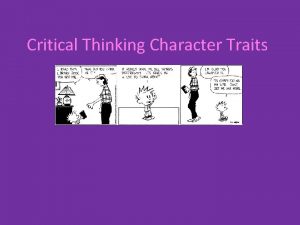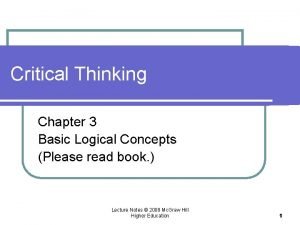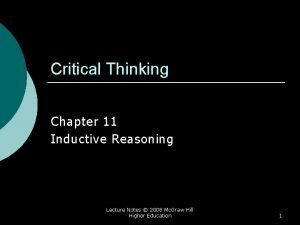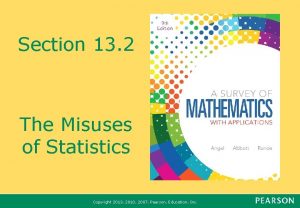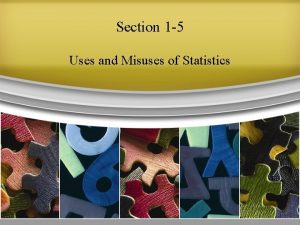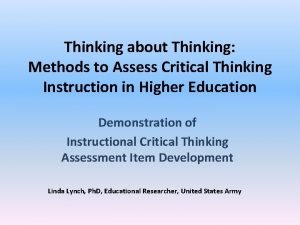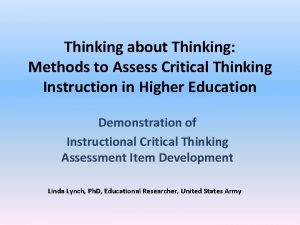SECTION 1 4 CRITICAL THINKING Misuses of Statistics







































- Slides: 39

SECTION 1 -4 CRITICAL THINKING

Misuses of Statistics 1. Evil intent on the part of dishonest people. 2. Unintentional errors on the part of people who don’t know any better. We should learn to distinguish between statistical conclusions that are likely to be valid and those that are seriously flawed.

Graphs To correctly interpret a graph, you must analyze the numerical information given in the graph, so as not to be misled by the graph’s shape. READ labels and units on the axes!

Graphs To correctly interpret a graph, you must analyze the numerical information given in the graph, so as not to be misled by the graph’s shape. READ labels and units on the axes!

Salaries of People with Bachelor’s Degrees and with High School Diplomas $40, 500 $40, 000 35, 000 30, 000 20, 000 $24, 400 25, 000 20, 000 Bachelor High School Degree Diploma (a) $24, 400 10, 000 0 Bachelor High School Degree Diploma (b)

Graphs To correctly interpret a graph, you must analyze the numerical information given in the graph, so as not to be misled by the graph’s shape. READ labels and units on the axes!

Pictographs Part (b) is designed to exaggerate the difference by increasing each dimension in proportion to the actual amounts of oil consumption.

Pictographs

Bad Samples Voluntary response sample (or self-selected sample) one in which the respondents themselves decide whether to be included In this case, valid conclusions can be made only about the specific group of people who agree to participate and not about the population.

In 1936 Literary Digest magazine sent more than 10 million ballots to readers to get their preferences in the upcoming presidential election between Franklin D. Roosevelt and Alfred M. Landon. The returns indicated that Landon, the Republican nominee, would win handily. Roosevelt won in the first great landslide election of the 20 th century. He carried all states except Maine and Vermont. What are some issues you could see with this poll? http: //www. britannica. com/ebi/article-9276570? &query=newspapers&ct=%22 ebi%22

Correlation and Causality Concluding that one variable causes the other variable when in fact the variables are linked Two variables may seemed linked, smoking and pulse rate, this relationship is called correlation. Cannot conclude the one causes the other. Correlation does not imply causality.

Correlation vs. Causation Examples q A study showed that truck drivers weigh more than adults who do not drive trucks. Conclusion: Trucks cause people to gain weight. q There is a strong relationship between a child’s knowledge of nursery rhymes at age 3 and their reading skills over the next few years. Does this mean that nursery rhymes cause children to be able to read better? Taken from Triola, Essentials of Statistics. Addison Wesley.

Correlation vs. Causation Examples

More Comical Examples…

Small Samples Conclusions should not be based on samples that are far too small. *In later chapters, we will discuss that samples should be of at least size 30. Example: Basing a school suspension rate on a sample of only ten students

Percentages Misleading or unclear percentages are sometimes used. For example, if you take 100% of a quantity, you take it all. If you have improved 100%, then are you perfect? ! 110% of an effort does not make sense.

Loaded Questions If survey questions are not worded carefully, the results of a study can be misleading. Survey questions can be “loaded” or intentionally worded to elicit a desired response. Example: “Do you believe that too little money is being spent on welfare? ” versus “Do you believe that too little money is being spent on assistance to the poor? ” Results: 19% say yes to the first question versus 63% to the second question.

Loaded Questions -- Phrasing Be careful of phrasing. Some examples: “Welfare” vs. “Assistance for the poor” “Pro-abortion” vs. “Pro-choice” “Elite” vs. “Expert” “Public servant” vs. “Bureaucrat”

Order of Questions are unintentionally loaded by such factors as the order of the items being considered. Example: “Would you say traffic contributes more or less to air pollution than industry? ” Results: traffic - 45%; industry - 27% When order reversed: “Would you say industry contributes more or less to air pollution than traffic? ” Results: industry - 57%; traffic - 24%

Nonresponse Occurs when someone either refuses to respond to a survey question or is unavailable. People who refuse to participate in a poll most likely will have a view of the world around them rather than someone who will gladly participate. **Think of skewness of Yelp and other survey/review websites.


Missing Data Can dramatically affect results. Subjects may drop out for reasons unrelated to the study. *People with low incomes are less likely to report their incomes. *US Census suffers from missing people (tend to be homeless or low income).

Self-Interest Study Some parties with interest to promote will sponsor studies (such as a business). Be wary of a survey in which the sponsor can enjoy monetary gain from the results. *When assessing validity of a study, always consider whether the sponsor might influence the results. **Example: Cereal companies funding studies on the importance of eating breakfast.

Precise Numbers Because a figure is precise, many people incorrectly assume that it is also accurate. A precise number can be an estimate, and it should be referred to that way. This often occurs with figures that are variable or frequently changing. Example: The US National Debt is $19, 349, 240, 034, 943 (7/14/2016). It would be more accurate to say that the US National Debt is approximately $19 trillion National Debt Clock

Deliberate Distortion (AKA Partial Pictures) Some studies or surveys are distorted on purpose. The distortion can occur within the context of the data, the source of the data, the sampling method, the conclusions, or simply through missing information. Example: A car insurance company advertises that their new customers saved an average of 15% by switching to this company’s policy. It is more likely that a few customers saved significantly, but the majority of customers saved little to create a 15% average.

Other Survey Issues Are the questions specific enough to draw conclusions from? Is the length of the survey appropriate? If the questions are multiple choice, are the suggested answers appropriate? Do they allow for all possibilities? Do they overlap?

Example 1: Use critical thinking to develop an alternative or correct conclusion: Based on a study showing that college graduates tend to live longer than those who do not graduate from college, a researcher concludes that studying causes people to live longer. College graduates tend to earn more money than nongraduates, and people who have more money are able to purchase better health care. Therefore, it is more likely that having more money (whether or not it resulted from having a college degree) is more likely the primary contributing factor toward longer life and not studying alone…though you should still study

Example 2: Use critical thinking to develop an alternative or correct conclusion: Data published in USA Today were used to show that there is a correlation between the number of times songs are played on radio stations and the numbers of times the songs are purchased. Conclusion: Increasing the times that songs are played on radio stations causes sales to increase.

Radio Stations tend to already play the most popular songs and therefore these are the songs that are already being purchased or vice versa.

Brain Break!

Example 3: Use critical thinking to develop an alternative or correct conclusion: A study showed a strong positive correlation between the annual consumption of diet soda drinks and the number of traffic accidents. Conclusion: An increase in diet soda consumption leads to more traffic accidents.

To be clear, these are very likely to have nothing in common, but here a couple of possibilities: One possibility: Perhaps diet soda drinkers are more likely to drink soda in their car than non-diet soda drinkers, therefore leading to more driving distractions and in increase in traffic accidents. Another possibility: Depending where these diet soda drinkers live, heavy traffic areas tend to have more traffic accidents, so therefore it looks like drinking diet soda has an effect on traffic accidents.

Example 5: Use critical thinking to address the key issue: In an ABC Nightline poll, 186, 000 viewers each paid 50 cents to call a “ 900” telephone number with their opinion about keeping the United Nations in the United States. The results showed that 67% of those who called were in favor of moving the United Nations out of the United States. Interpret the results by identifying what we can conclude about the way the general population feels about keeping the United Nations in the United States.

*We cannot conclude anything about the general population because: 1) Only viewers of the ABC “Nightline” program, which are not necessarily representative of the general population, were aware of the poll. 2) The 186, 000 persons who responded (and there is always a possibility that some people called more than once in order to give their opinion more weight) represent a voluntary response sample – which means that the responses will include an over representation of those with strong feelings and/or personal interest in the survey.

Example 6: Use critical thinking to address the key issue: The Hawaii State Senate held hearings while considering a law requiring that motorcyclists wear helmets. Some motorcyclists testified that they had been in crashes in which helmets would not have been helpful. Which important group was not able to testify? People who were killed in motorcycle crashes, when a helmet may have saved their lives, were not present to testify.

Example 7: Use critical thinking to address the key issue: Good Housekeeping magazine invited women to visit its Web site to complete a survey, and 1, 500 responses were recorded. When asked whether they would rather have more money or more sleep, 88% chose more money and 11% chose more sleep. Based on these results, what can we conclude about the population of all women?

Nothing. Because the information comes from a voluntary response sample, the opinions expressed are more likely to be representative of those with strong feelings on the topic than of the general population. Even if the information had not come from a voluntary response sample, the conclusion would apply only to women who read Good Housekeeping magazine and not to “all women. ”

Example 8: In the New York Times Magazine, a report about the decline of Western investment in Kenya included this: “After years of daily flights, Lufthansa and Air France had halted passenger service. Foreign investment fell 500 percent during the 1990 s. ” What is wrong with this statement? If something falls 100%, there is none remaining. To reduce investments by 500% would be to eliminate 5 times as many investments as there are to begin with – which is not physically possible.

Example 9: In a Gallup poll, 49% of 734 surveyed Internet users said that they shop on the Internet frequently or occasionally. What is the actual number of Internet user who said that they shop on the Internet frequently or occasionally? (49%)(734) = (49/100)(734) = 360 *49% sounds better than saying 360 out of 734.
 Critical semi critical and non critical instruments
Critical semi critical and non critical instruments Semi critical
Semi critical Perbedaan critical thinking dan creative thinking
Perbedaan critical thinking dan creative thinking Introduction to statistics what is statistics
Introduction to statistics what is statistics Define hypothesis testing
Define hypothesis testing Critical ratio statistics
Critical ratio statistics Slidetodoc.com
Slidetodoc.com Which is the hardest
Which is the hardest Critical thinking guidelines
Critical thinking guidelines Critical thinking examples
Critical thinking examples Relationship between creative and critical thinking
Relationship between creative and critical thinking How do we use critical thinking in everyday life
How do we use critical thinking in everyday life Circle of elements critical thinking
Circle of elements critical thinking At the end of the story, what makes montresor feel sick?
At the end of the story, what makes montresor feel sick? Critical thinking examples
Critical thinking examples Critical thinking validity
Critical thinking validity Active learning strategies to promote critical thinking
Active learning strategies to promote critical thinking Nursing inferences examples
Nursing inferences examples Five elements of critical thinking
Five elements of critical thinking Alliteration game ice breaker
Alliteration game ice breaker Critical thinking in group work
Critical thinking in group work Discussion questions for fahrenheit 451
Discussion questions for fahrenheit 451 Critical thinking definition
Critical thinking definition Foundation for critical thinking wikipedia
Foundation for critical thinking wikipedia Portable heating unit on the moon
Portable heating unit on the moon Objective claim
Objective claim Critical thinking cheat sheet
Critical thinking cheat sheet Nursing process objectives
Nursing process objectives Conclusion of critical thinking
Conclusion of critical thinking Critical thinking wheel
Critical thinking wheel Critical thinking and reflective practices
Critical thinking and reflective practices 5 components of critical thinking
5 components of critical thinking Critical thinking in nursing process
Critical thinking in nursing process How to use critical thinking
How to use critical thinking Objectives of critical thinking
Objectives of critical thinking Intellectual courage in critical thinking
Intellectual courage in critical thinking Critical thinking traits
Critical thinking traits Logic and critical thinking chapter 3
Logic and critical thinking chapter 3 Chapter 11 critical thinking
Chapter 11 critical thinking 5 components of critical thinking
5 components of critical thinking




